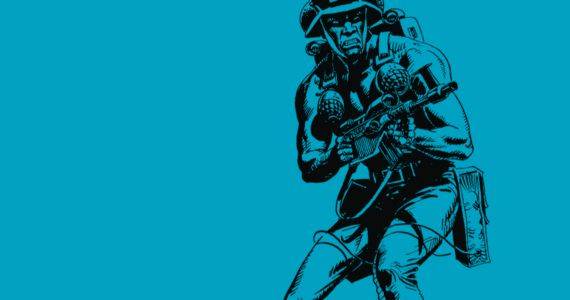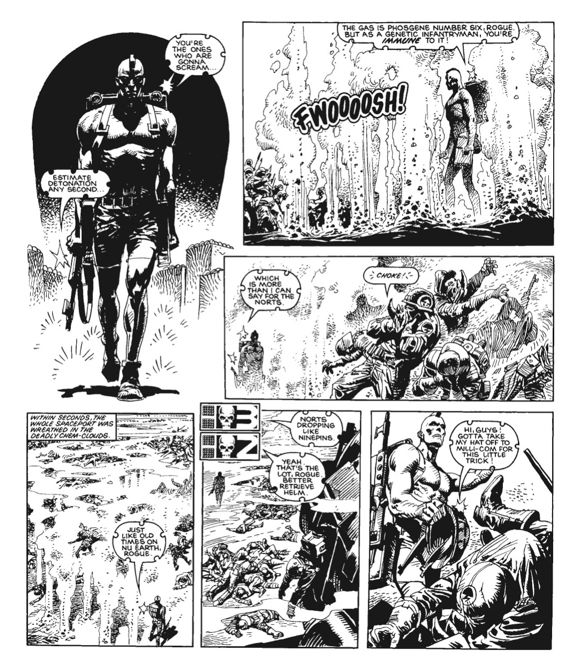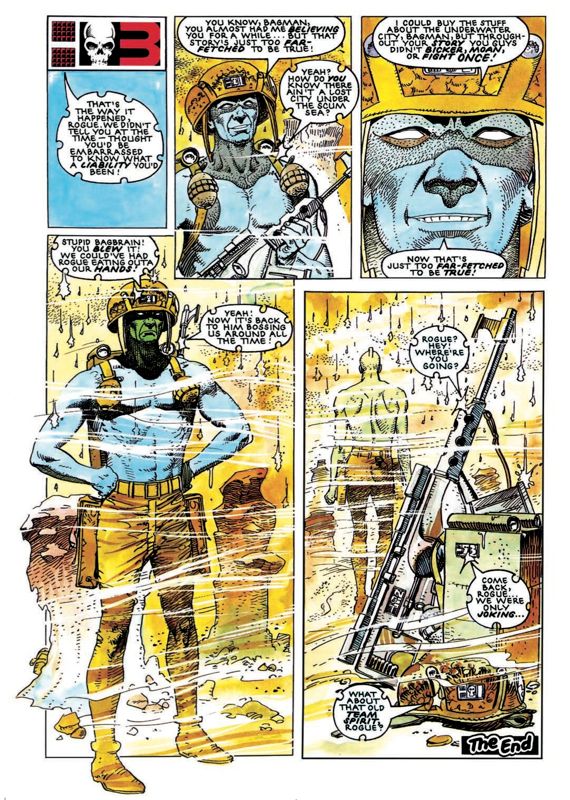This week sees the release in the United Kingdom of Rogue Trooper: Tales of Nu Earth Vol. 3, a collection of the final days of the original run of 2000AD's cloned science fiction soldier. Re-reading the book this weekend, it struck me how little the kid who read these strips at the time they were published appreciated some of the greatness they offered, how oddly ahead of its time Rogue Trooper was during the period these strips came from, and how surprisingly educational this book is for wonks like me who like to see how the comics sausage is made.
Let's start with that greatness. Look at this art by Jose Ortiz:
And now look at this art by Ortiz:
Seriously, Ortiz, who's one of two main artists on the strips collected in the book, the other being a pre-Deadline, pre-Preacher Steve Dillon, just kills with his art here. It's beautifully delineated, wonderfully clear and concise work, and the kind of thing that makes you wish that more people knew who Ortiz was. The book is worth buying for his art alone, but there's much more to it than that. For one thing, Dillon's not the only creator making an early appearance here. There's also early (mid-1980s) work from Peter Milligan and Grant Morrison to pick through and try and pull future themes from (Milligan's unreliable narrators! Morrison's obsession with virtual reality!), and the thing that always, without fail, pulls me into collected editions of old work: watching the creators try to retool and redirection the series while it's still continuing.
In a way, Rogue Trooper is an avatar for pop culture as we now know it; the original series ran from 1981 through 1989 before being canceled and rebooted, started over from scratch by co-creator Dave Gibbons and artist Will Simpson in a way that, at the time, was almost unheard of outside of the 1950s DC relaunch that heralded the Silver Age (and even then the characters rebooted had been out of the public eye long enough to be forgotten/unknown to their target audience of kids). These days, we're used to reboots of familiar characters and concepts, but Gibbons and Simpson's Rogue Trooper reboot came less than a year after the character's earlier storyline had concluded.
What Tales of Nu Earth Vol. 3 collects are the final stories before the reboot (with the exception of the very final story, a flashback series called "Cinnabar" set earlier in the series' continuity), and they're fascinating to read in a historical context, because from the very start, the creators are already trying to come up with a new take on the series; either they were convinced that the "future war" setting was getting dull for readers or they believed that the series needed a more obvious hook, because there are at least two dramatic shifts in direction within the book - First, Rogue has to find who has sabotaged peace talks and work with the enemy in doing so, and then, he ends up working with the saboteurs because the peace talks were all a sham and only he can bring about peace by assassinating key figures on both sides of the war. Both have potential to them, but never quite find their feet, and watching the creators stumble and realize the dead ends they wander into has a surreal car-crash quality that's equally educational and frustrating.
Similarly, the story that brings the continuity to a close is surprisingly abrupt, and the kind of thing that feels more like editorial edict being carried out by impatient creators who nonetheless have genuine affection for the characters -- there's an entirely unlikely happy ending, after all, a sure sign of sentiment, ending the regular run on somewhat of a bittersweet, exhausted note. (The book actually continues past that, collecting stories from outside the regular 2000AD weekly run from the same period that featured the character, including one by Morrison and Simpson that may have been the thing that got him the gig working with Gibbons on the reboot; it's great-looking stuff.)
Tales of Nu Earth Vol. 3, then, isn't necessarily a collection of "classic" work unless your only definition of "classic" is "old"; the art is consistently impressive and successful, but the writing far less so, filled with uncertainty, abrupt changes in direction and tone and narrative dead-ends. But nonetheless, it's something I couldn't put down once I'd started, and something I've gone back to since that first reading to unpick and try to read between the lines. Even if the idea of a genetically cloned super-soldier fighting to end a future metaphor American Civil War doesn't sound appealing to you at all, if you have any curiosity about the ways in which creators try to pull apart concepts without unraveling them completely in order to make them work, this is genuinely a must-read book. Find those import copies now, people.



